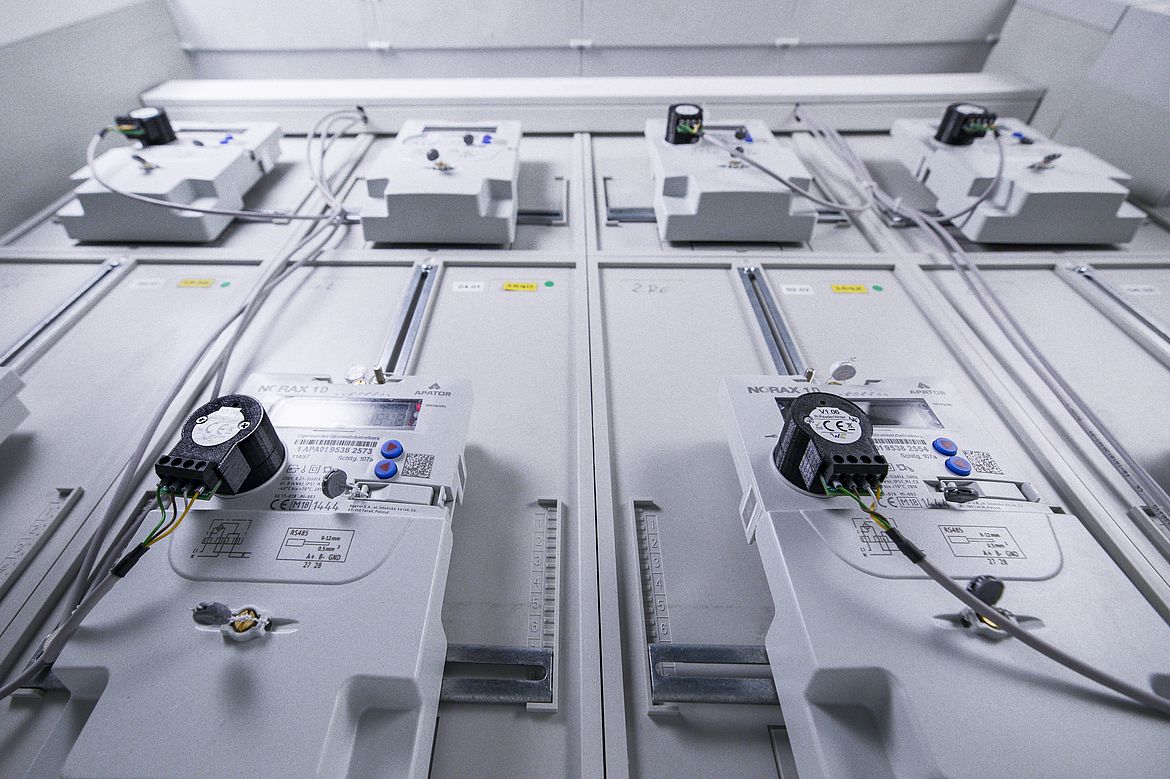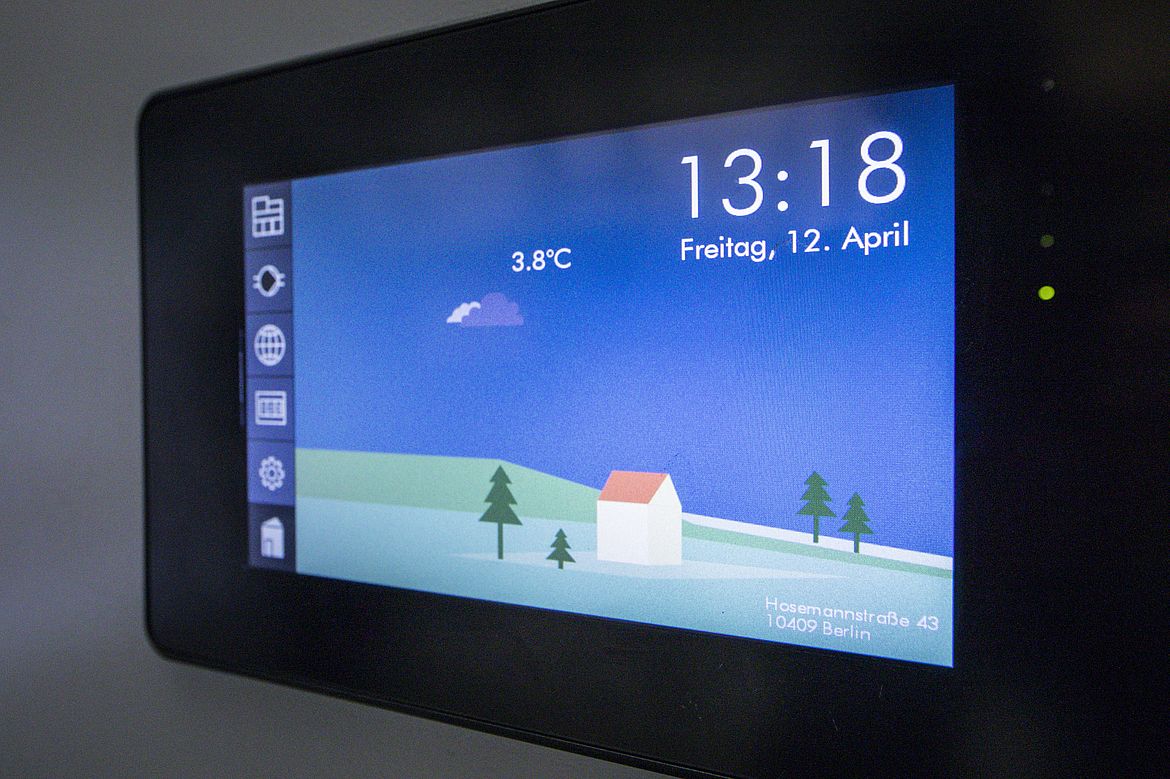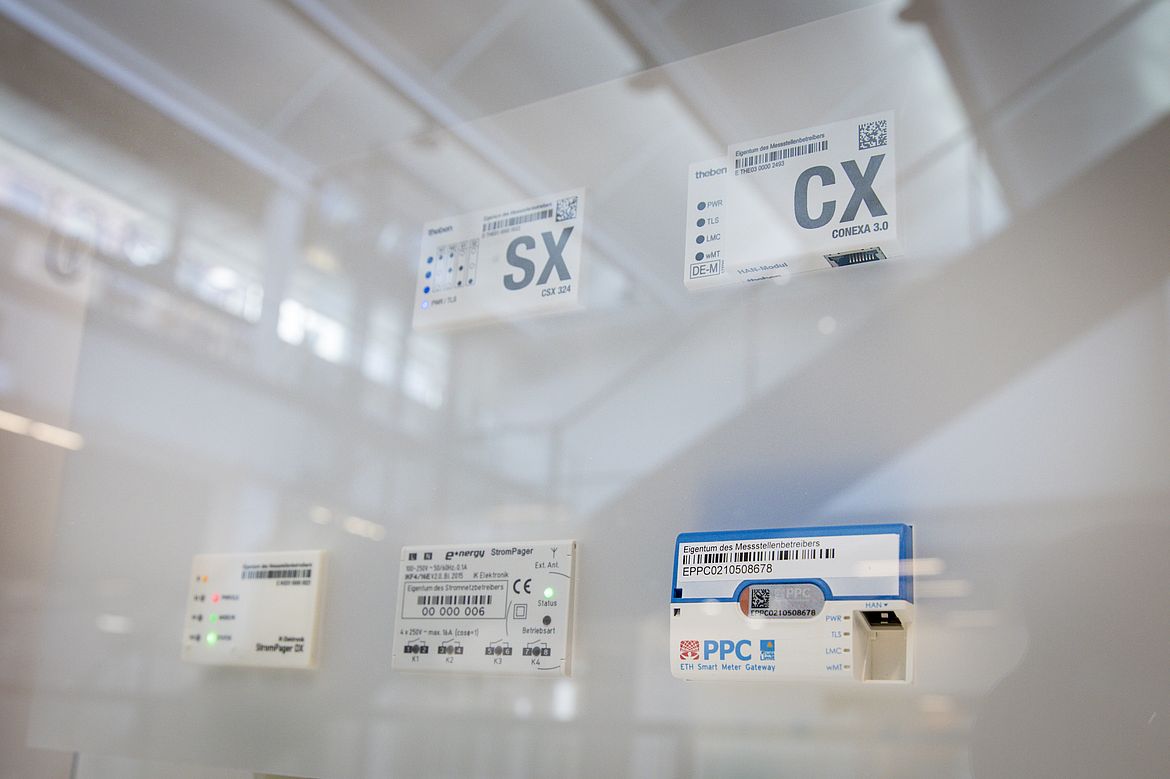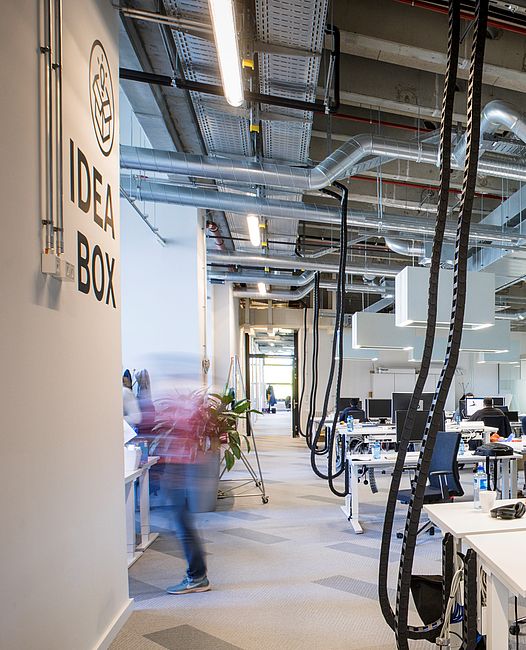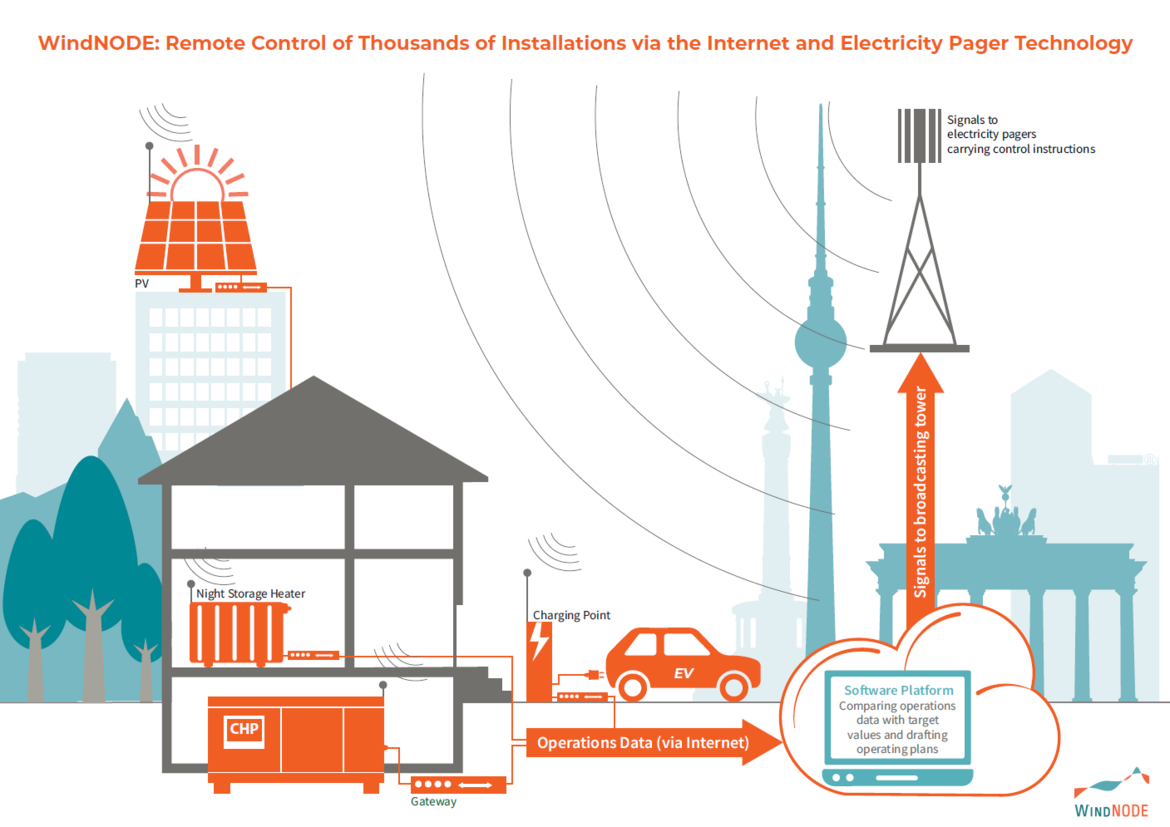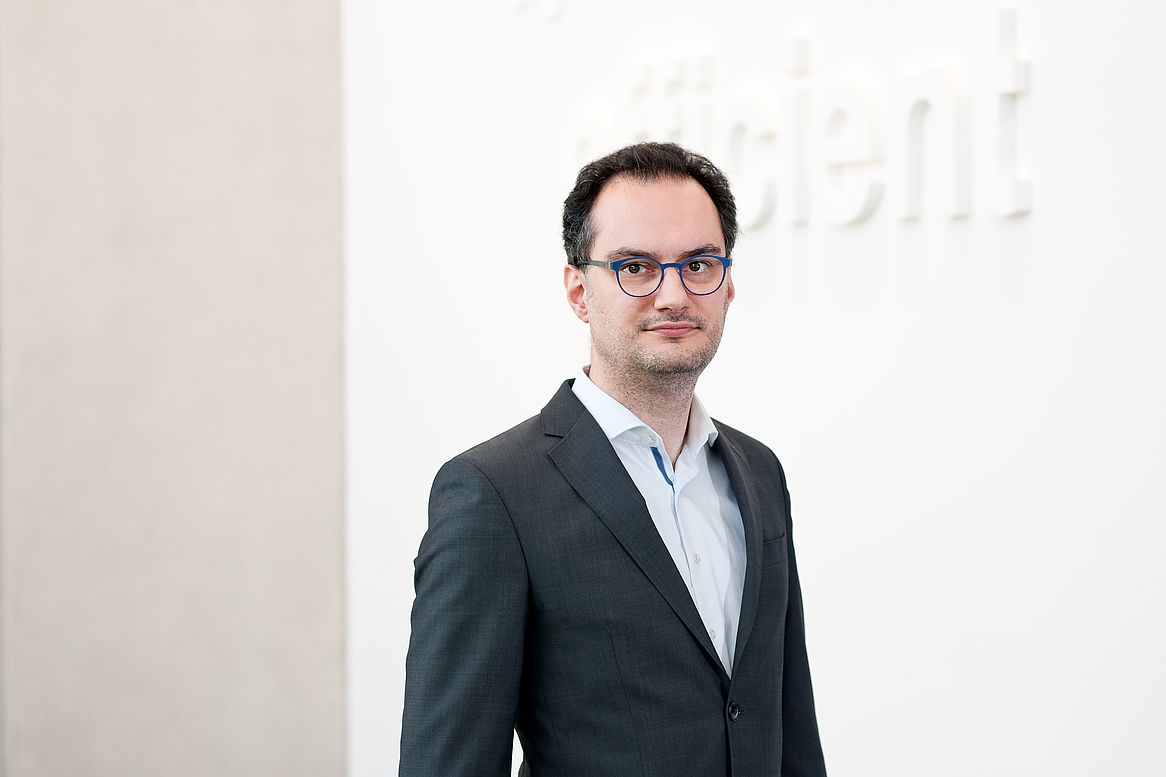The operating system of the energy transition
In the scope of WindNODE, software and hardware developers such as Bosch Software Innovations* and devolo are developing and testing the technology to mobilise thousands of small installations for the energy transition together with system operator Stromnetz Berlin. This will form the digital backbone for the power grid of the future.
“In the scope of WindNODE, we are building the digital network for a new world of energy,” promised Dr. Sandra Maeding. However, the hallway in the building complex from the 60s in Berlin’s Prenzlauer Berg district could not be more mundane: roughcast, concrete steps, flimsy handrails. “Did you expect something more spectacular?” asks the project manager of Stromnetz Berlin with a smile. She leads us further, takes the stairs to the cellar and heads for the heating system. Then, she opens the fire-proof door, showing us a tidy and empty interior with only a combined heat and power unit (CHP) that is emitting a low hum. A labyrinth of insulated heating pipes covers the ceiling. A white and beige meter box hangs on the wall. A new world of energy? Or just another cellar like there are thousands of others in Berlin?
“If we want the energy transition to be a success, we especially have to implement it in such everyday places,” says Maeding. The particularity is in fact the normalcy. Even in the meter box, only dark components the size of a salt shaker show that part of the power grid of the future is being created inside this building complex in the scope of the WindNODE project “Networked End Consumers: Controllable Loads and New Services”. More specifically: the grid remains as it is for now, but is controlled digitally.
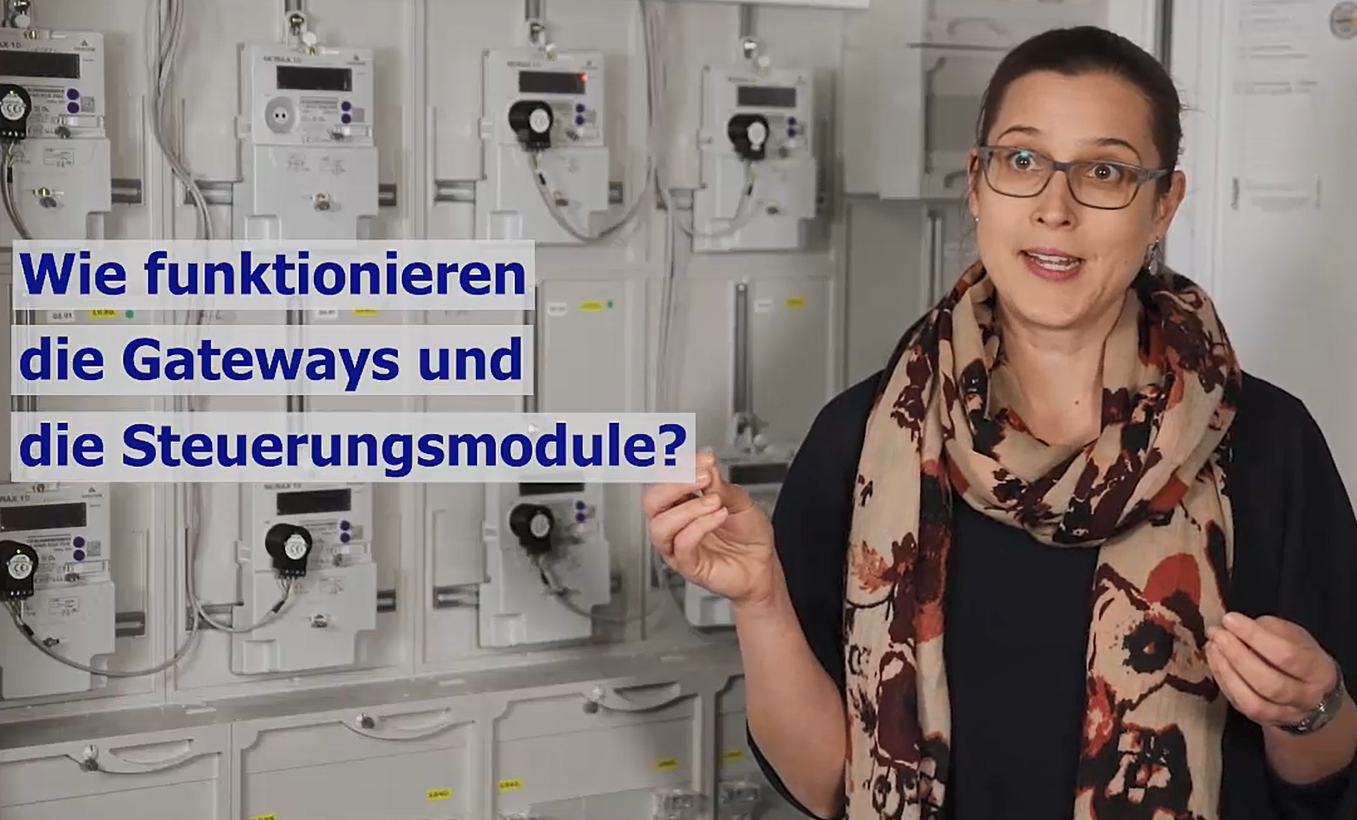
▶ Play
The YouTube video will only load and play after clicking. By clicking the video, you agree to Google’s Privacy Policy.
The supposed ‘salt shakers’ are optical couplers (“optocouplers”) that read out the consumption of electricity for each of the 224 homes in six buildings. They then send these data to monitors in the homes, on which the tenants can view their electricity consumption and control the heating of their flats.
90,000 gateways for Berlin
Yet for WindNODE, something else is even more important: “We are planning to install a smart meter gateway here,” explains Maeding. The gateway is the digital doorway through which the data from the digital meters, also called modern metering devices, are sent to the outside: this is an important step to couple the power grid to information technology. Stromnetz Berlin wants to install about 90,000 intelligent metering systems, commonly referred to as smart meters, in the scope of the rollout at major electricity consumers in Berlin.
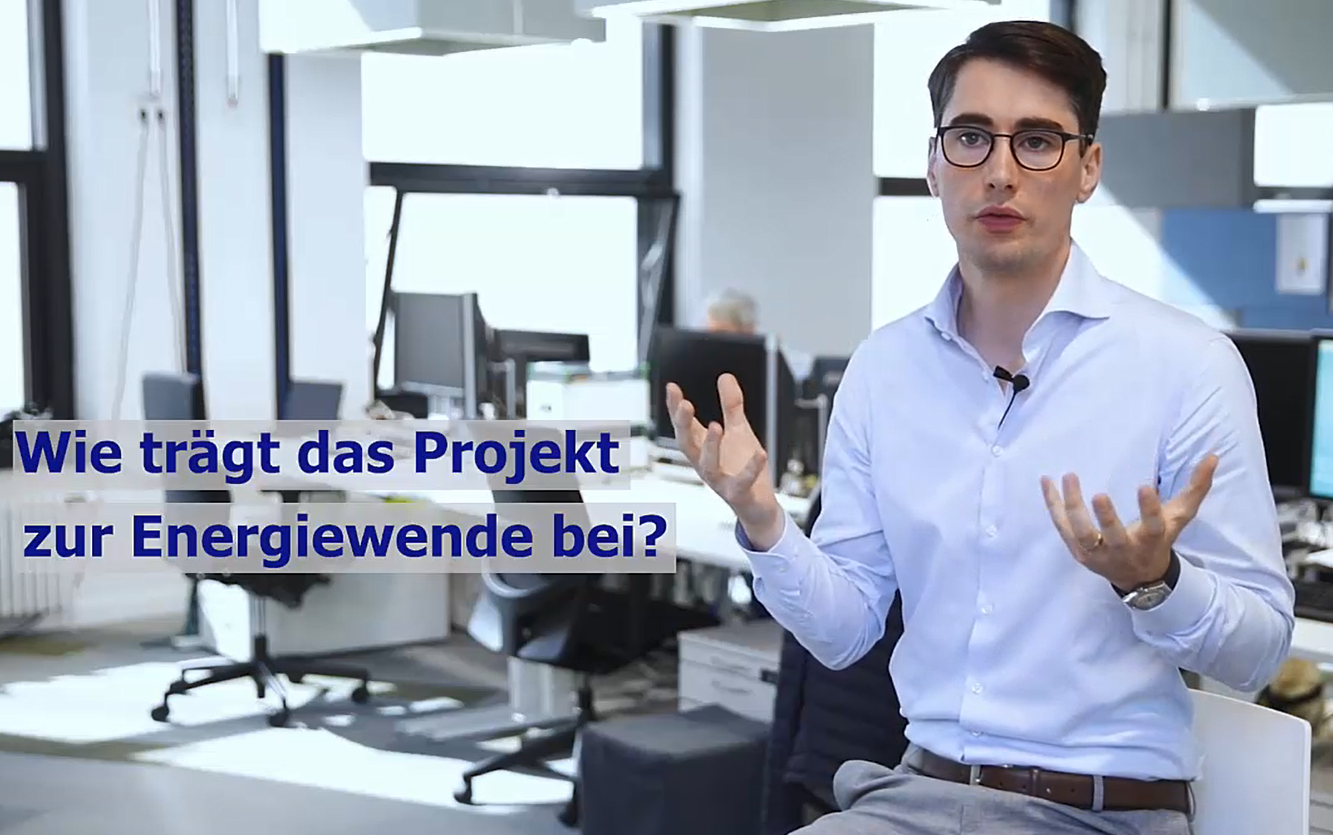
▶ Play
The YouTube video will only load and play after clicking. By clicking the video, you agree to Google’s Privacy Policy.
The data are first transmitted to the server of Stromnetz Berlin. Stromnetz Berlin is not only responsible for the metering points, but also for the further development of the power grid. And here the not-so-distant goal is to simultaneously keep an eye on Berlin's power grid, automate electricity billing and monitor tens of thousands of small solar systems and power consumers from cold stores to electric cars - so-called "low-voltage electrical systems". And if the stability of the power grid requires this, also to activate and deactivate them.
An approach to solve this monumental task is the development of a specific software platform. "Ultimately, it's about the operating system of the energy revolution," says Mark Nigge-Uricher, technical project manager at Bosch Software Innovations, summing up the demands placed on the platform.
"Many different software processes have to be set up under the umbrella of such a software platform," explains Mark Nigge-Uricher, technical project manager at Bosch Software Innovations. "In the scope of WindNODE, we have the unique opportunity to test and further develop our 'Meter Gateway Manager' software in practice.
- the software for the operation of the gateways, the so-called gateway manager for the operation of the smart meter gateways, and the metering data hub, which is responsible for handling the electricity data in accordance with the legal (security) provisions;
- the expansion of the software for data from digital gas and water meters (so-called multi metering), as well as
- the expansion of the meter gateway managers and the metering data hubs with so-called electricity pagers, which can switch electricity consumers and small solar installations.
Background image: The Ullstein-Haus in Berlin from the outside. This is where the programmers at the Bosch Campus from Bosch Software Innovations work ©ahnenenkel.com/Silke Reents
In the Ullsteinhaus, programmers are sitting in front of large monitors on which the rhombuses, circles and rectangles of their flow diagrams are connected by thin arrows and lines. “If, then”, “Go to...”, “Send to...”: they are puzzling to ensure that the software has a programming line for each individual case. This is a world of expert slang and acronyms: Workflow Connector, Controllable Load, MDM, SMGWA and iMSys.
The concrete meaning of all this is shown in the cellar of the building complex in Prenzlauer Berg. Sandra Maeding of Stromnetz Berlin invites her visitors to imagine that this is their cellar and their small CHP unit. In that case, they could for instance come up with the idea to only use
wind power and also install a battery. It would also be possible to convert excess wind power into heating energy or hot water using heating elements (Power-to-Heat) in the available water tanks or also to make the small CHP unit available for control power with an energy trader as intermediary. But how?
The first step is the gateway, which for the first time ever transmits current data on power consumption and CHP power to the outside; at this point in WindNODE, the power grid operator Stromnetz Berlin uses a gateway from hardware supplier devolo and Bosch Software Innovations software for this exact purpose.
Data security through digital one-way streets
In order to curtail or ramp up the CHP unit or the battery from outside, high data protection and data security challenges have to be met. Power grids are by law part of the “critical infrastructure”, the “outage or impairment” of which “could have dramatic consequences” according to the act. Strict cyber security requirements apply here.
The Federal Office for Information Security (BSI) has defined correspondingly high standards for the gateways. “Here, we are additionally setting up an entirely new kind of technology for the control of installations such as this CHP unit as well as night storage heaters,” says Maeding.
The debate on the energy transition often mentions such “switchable loads” and the “consumers’ flexibility reserves”.
The principle is clear: in the power grid, the consumption of electricity has to be just as large as the generation. When there is a lot of green electricity on the grid, electricity consumers, from residential areas to factories, should ideally consume more electricity if possible. And when there is no electricity due to a lack of wind or sunshine, then it should be possible to reduce part of the power consumption. In the local distribution grid of system operators such as Stromnetz Berlin, however, it is at the same time important to reach as many medium-sized consumers as possible, for example commercial customers, with control signals. In doing so, the load limits of the local power grids can of course not be exceeded.
Combined heat and power plant in the basement of the settlement on the Hosemannstraße in Berlin Prenzlauer Berg(©ahnenenkel.com/Silke Reents)
Replacing ripple control
Such flexible consumers are an indispensable part of the energy transition. Individual installations such as industrial cold stores, night storage heaters and many street lights can in fact already be activated and deactivated remotely. Traditionally, the system operators mainly intervene here when the security of their power grid is at risk. To this end, the so-called audio frequency ripple control (AFRC) is already being used: a technology of the 1950s that sends signals through the electricity lines. In the meantime, AFRC has reached the end of its useful life, making the operation of such a system appreciably less efficient.
One requirement for the replacement technology being pursued is that it has to be constantly available in the cellars of the homes as well.
Today, the internet and many mobile radio frequencies are available, at least in theory. But not every boiler room has an internet connection and mobile communication standards such as the cellphone network cannot be used for another reason: “Take a look at your phone,” says Sandra Maeding in the cellar in Prenzlauer Berg. “You have no reception here.” Even in Berlin, which has a mobile communications coverage of almost 100 per cent, GSM technology would only work reliably in two out of three cellars.
The return of the pager
More compact and more advantageous is a type of technology that we now only remember from 90s’ hospital soaps: the pager. This beeper the size of a matchbox once adorned the belts of doctors who wanted to be in touch at all times, even before the days of worldwide mobile communications. In Germany, the former Telekom established this paging network, and later sold it to the company e*message. Today, the company mainly offers services to fire departments and private (security) companies. Pagers are similar to radio and television: the signal is transmitted from a broadcasting tower and can be received by as many devices as needed. This pager signal is so strong, that it also reaches 99 per cent of all of Berlin’s cellars.
“Part of our development within WindNODE is to also integrate the control of the pagers into our software platform,” explains Mark Nigge-Uricher of Bosch Software Innovations. The electricity pager should be used to alter the output of installations such as combined heat and power units or batteries as wanted by the operator or his electricity traders. However, because it is a unidirectional system, the pager cannot report back whether the installation also understood and executed the signal. This information, and this is where the circle is closed, should be sent to the software platform through the gateway. The software platform must then be able to correspondingly process the responses from the pager.
"While the roll-out of the smart meters that have been certified for the free market is taking some time, we already have several hundred systems in use in the scope of WindNODE and can test the interaction of hardware and software in a real test environment," says Nigge-Uricher. Sandra Maedig of Stromnetz Berlin also emphasises: “We are not inventing new technology, but repurposing existing technology in a new system.”
In Berlin, Stromnetz Berlin will equip some 90,000 consumers with an electricity demand of over 6,000 kilowatt-hours or an own generating unit of over seven kilowatts with modern metering devices and smart meter gateways.
In order to gather more information through the own distribution grid in Berlin as well, about 3,000 secondary substations in the power grid are being equipped with field instruments that provide the control room with high resolution measurements from all low voltage feeders. Maeding: “As a result of the digitisation, we will be able to operate the grid even more securely and have even better knowledge of the direction which the expansion should take. This is even more important with the arrival of new consumers such as electric vehicles, altering the requirements for the power grid.”
Seven questions for...
Christoph July is the WindNODE project leader and research coordinator at hardware developer devolo. He seeks to use the opportunities for experimentation offered by WindNODE to combine devices from heat pumps to solar panels into a single plug-and-play system that can then be managed by a cellphone app.
„We are entering uncharted territory“
As hardware provider for the energy industry, we are testing our gateways in actual practice on a large scale within the scope of WindNODE. WindNODE is the ideal test field for developers like us to carry out all interoperability tests in a real environment. For example: we tested the interaction between our smart meter gateway and Bosch’s software on the one hand, and the compatibility of the smart meter gateway with different energy meters and distributed energy units on the other hand. In the meantime, the tests have been concluded successfully: now, all necessary functions of the hardware and software package are available.
The cooperation in the scope of WindNODE with users such as Stromnetz Berlin and software developers like Bosch Software Innovations offers a great many impulses for development on all sides. We have noticed what the hardware for the operating system of the energy transition should deliver in the future as wanted by users and practitioners. This helps the digitisation of the energy transition in its entirety. It is good for each individual company to be at the forefront within WindNODE.
At devolo, 15 employees are working on the WindNODE project. Most of these IT engineers are the same ones who rolled out the test environment in the Ullsteinhaus. Much of what we try out here was still in the prototype phase. Now, the software developers can drive forward the interfaces between the hardware and the Bosch software or the system operator. In this WindNODE process, the product managers also receive additional requirements from energy suppliers, which is useful for both parties.
In Germany, the rollout of the digital electricity meters has been delayed because by mid 2019, not enough smart meter gateways had been certified by the states. This prevents all hardware and software developers to test their technology and programs in practice on a large scale. In the WindNODE project, we were able to set up a test field with the other partners in which our hardware and the software of Bosch work together. This is showcased in the Ullsteinhaus on the Bosch campus, where the software developers are also based.
We have noticed that the digitisation of the energy transition in its entirety has to evolve more swiftly towards the age of apps and plug-and-play. In the future, we want end customers with smart meters - whether private households or businesses - to be able to use an app on their smartphone to find out about their current consumption. According to the applicable measuring and calibration laws, these data may only be read out using special transparency and display software. The imaginable applications for end customers, however, do not concern a precise reading of each individual kilowatt-hour in accordance with calibration law.
We envision a smart meter gateway that recognises devices connected via a "Discovery Service" such as heat pumps, heaters, wall boxes or solar systems. The functional scope and status information of the managed devices can be made available directly to the user via standardised, customer-friendly software interfaces. In the scope of WindNODE, we have baptised this concept “Controllable Local Systems Service”, which is an added value service for the customers. A simple integration, for example in an existing smart home system, is possible. Another scenario beyond the local scope is the connection of a larger group of controllable devices directly to an energy management system such as Bosch’s via the same interfaces. The customer can then centrally manage his private energy infrastructure and possibly also make flexibility available to the electricity market.
We want to create a system in which each new device, such as a heat pump, an electric charging station or a solar system, can be recognised immediately. The customer can then obtain an overview of the consumption using live data and, more importantly, manage the individual units. As soon as a plug-and-play system based on internet protocols exists, there will also be providers who offer new services to the customers so that they can save energy as well as money. In the scope of WindNODE, we are entering uncharted territory, facilitated by the experimentation clauses of the SINTEG regulation.




